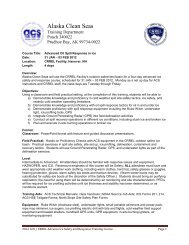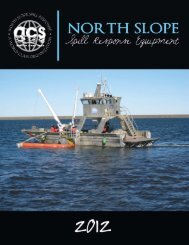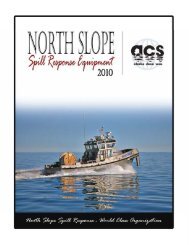(ACS) Technical Manual - Alaska Clean Seas
(ACS) Technical Manual - Alaska Clean Seas
(ACS) Technical Manual - Alaska Clean Seas
- No tags were found...
You also want an ePaper? Increase the reach of your titles
YUMPU automatically turns print PDFs into web optimized ePapers that Google loves.
TACTIC C-8 Deflection Booming in Stream (Page 3 of 6) Deflection Booming in Stream (Page 4 of 6) TACTIC C-8NOTE: “Base Location” is storage location (may change seasonally); “Mobe Time” is time to get it out of storage, prepare it foroperation, and make it ready to travel (concurrent for all equipment); “Deploy Time” is time to make it operational for its intended useat the spill site. These times do not include travel time from base to spill site, which may have multiple components (see Tactic L-3).CLOSED CHEVRONEQUIPMENT AND PERSONNEL• Select vessels and boom according to area, water depth restrictions, and function (see Tactic L-6). Specific personnelrequirements depend on the length and type of boom and the nature of the area.SkimmerDeadmanCurrentEQUIPMENTBASELOCATIONFUNCTIONPIECES# STAFFPER SHIFTMOBETIMEBoom All Deflection booming >50 ft1 hrWork Boat All Booming support 39 for setup3 to maintain*1 hrAnchor System All Anchoring boom Variable 1 hrDEPLOYTIME3 hr*Recovery crews can assist with monitoring boom if necessary.SUPPORTSkimmerOPEN CHEVRONEQUIPMENTAvgas TrailerBASELOCATION<strong>ACS</strong>, GPB, KRU,Badami, AlpineFUNCTIONPIECES# STAFFPER SHIFTMOBETIMEDEPLOYTIMEAirboat fuel 1 1 (initial) 1 hr 0.5 hrMechanic Support All Support equipment 1 1 1 hr 0.5 hrSkimmerDeadmanCurrentDEPLOYMENT CONSIDERATIONS AND LIMITATIONS• 8x6 Delta boom is most commonly used for this tactic.• Since the speed of the current perpendicular to the boom must be maintained at 3/4 kt or less, the length ofboom needed to stretch across a stream depends on the current. For a stream 100 ft across with a 1 kt current,a boom approximately 140 ft long is needed. If the current is 2 kt, the same stream would require 320 ft of boom.The speed of the current is not equal across the stream; the fastest water is with the deepest water. Oil movingin a stream will be entrained in the fastest water.• The shortest length of boom available is 50 ft. Generally, the minimum length required to boom a river such asthe Sagavanirktok or Kuparuk is 500 ft.SkimmerChevron boom configurations are also for use in fast water. Two booms are deployed from an anchor in the middleof the stream and attached to each bank. A chevron configuration is used to break a slick for diversion to two ormore collection areas. An open chevron can be used where boat traffic must be able to pass. (The two booms areanchored separately midstream, with one anchor point upstream or downstream of the other).• Readjust angles and widths between boom sections as current and wind change. Constantly monitor nearshoreboom systems to prevent escape of oil.• Approval from the Operations Section Chief is required for any vehicle tundra travel (off-road or off-pad), whichmust be in accordance with <strong>ACS</strong>’ emergency tundra travel permit (See Tactic A-3). Any excavations in tundra orany tundra damage must be reported to the Operations Section Chief. All on-tundra activity must be documentedand reported to the Planning Section for reporting to ensure permit compliance. Avoid archeological sites andbiologically sensitive habitats. Travel across tundra with tracked vehicles, heavy equipment, and even foot trafficcan seriously damage the vegetative mat, induce thermokarst, and cause structure disturbance. Using sheets ofplywood as a traveling surface and minimizing trips with equipment greatly reduce disturbance of the tundra.CURRENT(knots)CURRENT(ft/second)BOOM ANGLE RELATIVE TO CURRENTREQUIRED TO KEEP COMPONENT OFCURRENT






